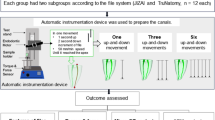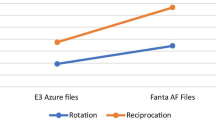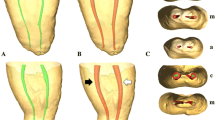Abstract
The aim of the present study was to compare the cutting efficiency of Twisted File instruments used in continuous rotation or TF Adaptive motion and evaluate if prolonged use significantly affected their cutting ability. 20 new NiTi instruments were used in the present study (TF tip size 35, 0.06 taper; Sybron-Endo, Orange, CA, USA), divided into 2 subgroups of 10 instruments each, depending on which movement was selected on the endodontic motor. Group 1: TF instruments were activated using the program TF continuous rotation at 500 rpm and torque set at 2 N; Group 2: TF instruments were activated using the reciprocating TF Adaptive motion. Cutting efficiency was tested in a device developed to test the cutting ability of endodontic instruments. Each instrument cut 10 plastic blocks (10 uses) and the length of the surface cut in a plastic block after 1 min was measured in a computerized program with a precision of 0.1 mm. Maximum penetration depth was calculated after 1 use and after 10 uses, and mean and standard deviation (SD) of each group was calculated. Data were statistically analyzed with a one-way ANOVA test (P < 0.05). TF instruments used in continuous rotation (Group 1) cut a mean depth of 10.4 mm (SD = 0.6 mm) after the first use and 10.1 mm (SD 1.1 mm) after 10 uses, while TF instruments used with the Adaptive motion cut a mean depth of 9.9 mm (SD = 0.7 mm) after the first use and 9.6 mm (SD = 0.9 mm) after 10 uses. There was no statistically significant difference between the two groups investigated (P > 0.05) nor between instruments after 1 or 10 uses. In conclusion, the TFA motion showed a lateral cutting ability similar to continuous rotation and all tested instruments exhibited the same cutting ability after prolonged use.
Similar content being viewed by others
Avoid common mistakes on your manuscript.
Introduction
An important property of nickel–titanium (NiTi) endodontic instruments is the cutting efficiency [1]. NiTi endodontic instruments nowadays are produced in a variety of design and manufacturing processes, each aiming to improve performance and safety [2–4]. The capability of an instruments to efficiently remove dentin is a complex interrelationship of different parameters, including cross-sectional mass and design, helical and rake angle, number and depth of the flutes, tip design, hardness of the alloy and manufacturing processes, including electropolishing, heat treatments and coating of the instruments [5]. Cutting efficiency is also dependant on the instrument motion [6]. Recently, reciprocating NiTi instruments were introduced to the market [7–9]. Gambarini et al. [10] showed that changing the motion by modifying the angles of reciprocation could significantly affect the resistance to fracture of the instruments, and also the ability to cut dentin and remove debris. These findings were confirmed in a recent study from Plotino et al. [1], comparing cutting ability of two reciprocating instruments.
In 2013, a new innovative reciprocating motion and instrumentation technique (TF Adaptive; SybronEndo, Glendora, CA, USA) was introduced [11]. The TF Adaptive (TFA) clockwise (CW) and counter-clockwise (CCW) reciprocating angles are not predefined, but the motor automatically and continuously changes them, according to the intracanal stress. Manufacturer claims that this proprietary motion would reduce both torsional and flexural stress by periodically reversing the rotation, without any significant decrease in the cutting ability of the instruments.
Although extensive studies were conducted on the cutting ability of hand and rotary endodontic instruments [12–20], little data are available on the cutting efficiency of these new reciprocating instruments [1, 6]. Moreover, no scientific articles were published to evaluate whether differences in motion may affect the cutting ability after a prolonged use. Therefore, the aim of the present study was to compare the cutting efficiency of TF instruments used in continuous rotation or TFA motion, and evaluate if prolonged use significantly affected their cutting ability.
Materials and methods
A total of 20 new NiTi instruments, 25 mm in length, were used in the present study (TF tip size 35, 0.06 taper; SybronEndo, Glendora, Ca, USA). Subsequently, the instruments were randomly divided into 2 subgroups of 10 instruments each depending on which movement was selected on the torque-controlled endodontic motor used (TFA motor; SybronEndo, Glendora, Ca, USA). Group 1: TF instruments were activated using the program TF continuous rotation at 500 rpm and torque set at 2 N; Group 2: TF instruments were activated using the TF Adaptive motion (speed and angles not disclosed by manufacturer). All the instruments were activated by using a 6:1 reduction handpiece.
To eliminate the variability due to possible different mechanical characteristics of dentine specimens, special Plexiglas plates (30 × 30 × 1 mm) created from the same original raw material were used (Inplex, Rome, Italy). Each instrument was used consecutively 10 times on different plastic plates, while each plastic block was used to test one instrument from each of the two groups tested, and thus 100 blocks were used. Cutting efficiency of all instruments was determined by means of a specially designed testing device already used in previous studies [1, 6]. It consisted of a main frame to which a mobile plastic support for the handpiece was connected and a stainless-steel block containing the Plexiglas plates against which the cutting efficiency of the instruments was tested. The dental handpiece was mounted upon a mobile device connected to a fixed weight that for gravity drove the horizontal instrument against the Plexiglas block in a precise and reproducible way (Fig. 1). The same 150 g weight was used to test all instruments. To prevent the instruments from slipping out the smooth surface of the plastic, a notch 1 mm in depth and width was created on the lateral wall of the Plexiglas plate that measured 1 mm in thickness. The plastic support for the handpiece allowed for precise and simple three-dimensional alignment and positioning of the instrument, as soon as it came perpendicularly into contact with the notch created on the wall of the Plexiglas specimen without bending. The cutting efficiency was tested 8 mm from the tip of each instrument. Once everything was fixed, the motor of the testing device was switched on and the instrument removed material and penetrated actively. To permit removal of plastic debris created by the instrument during the test, an air compressor was attached and used during all the experiment. Each instrument was tested in linear cutting unidirectional lateral motion and the maximum penetration depth of the instruments was the criterion for cutting efficiency and the basis for the comparison as a function of time. The precise length of the plastic block cut in 1 min was measured in mm for all groups tested using a computerized program (Adobe Photoshop CS4) with a precision of 0.1 mm. The 1 mm notch was subtracted to the length obtained. Maximum penetration depth was calculated after 1 use and after 10 uses, mean and standard deviations of each group were calculated and data were statistically analyzed with a one-way ANOVA test with significance set at 95 % confidence interval. Three new instruments and three instruments used 10 times from each group were analyzed through SEM analysis (Philips SEM 515, Eindhoven, The Netherlands) to evaluate possible differences in the characteristics of the surfaces of new and extensively used instruments.
Results
TF instruments used in continuous rotation (Group 1) cut the Plexiglas block to a mean depth of 10.4 mm (Standard deviation, SD = 0.6 mm) after the first use and 10.1 mm (SD = 1.1 mm) after 10 uses, while TF instruments used with the Adaptive motion cut the Plexiglas block to a mean depth of 9.9 mm (SD = 0.7 mm) after the first use and 9.6 mm (SD = 0.9 mm) after 10 uses. There was no statistically significant difference between the two groups investigated (P > 0.05) nor between instruments after 1 or 10 uses (P > 0.05).
Discussion
Many articles have investigated the cutting ability of endodontic instruments using different techniques: measuring the changes in dentin thickness, in root canal volume and in debris generated during instrumentation, analyzing weight loss of teeth, resin blocks or Plexiglass plates or the penetration depth of the instrument into the lumen of special plastic samples with a cylindrical canal, or clinically evaluating the instrumentation for example in terms of preparation time [12–20].
In the present study, samples were tested in a new device specifically developed for cutting test, with a methodology validated in the previously published researches [1, 6]. The instruments tested were identical in size and manufacturing process, as they have both tip size 35 and 0.06 uniform taper, same cross-sectional and flute design and are produced with the same heat treatment. Therefore, the difference in cutting ability can be only related to the different movement in which the instruments were tested. Cutting efficiency was examined in the present study by operating the instruments on plastic samples, as some studies discouraged testing with teeth because of their variable hardness and water content [16, 21, 22]. The use of plastic allows direct comparisons of the cutting ability of different instruments tested on identical samples [17], eliminating variations in hardness that may influence results; however, plastic does not exhibit the same properties as dentin and thus may not provide clinically relevant data.
The results of the present study showed no statistically significant differences between the cutting ability of TF instruments tested in continuous rotation or with the TF Adaptive motion. This could be explained by the fact that the cutting angles (in CW direction) of TFA instruments range from 370° to 600°. These instruments perform a full rotating cycle before reversing the rotation (with small releasing angles in CCW direction ranging from 0° to 60°). This movement permits the TFA instruments to cut as smoothly and efficiently as the same instruments used in continuos rotation. Moreover, the testing device used in the present study, permit the instruments to cut only in a very small portion of its cutting area, with minimal blade engagement. As a consequence, the TFA motor detects low torque values and perform a TFA motion which aims at improving efficiency and not safety (600°–0°). The adaptive motion is a reciprocation that automatically selects the two angles depending on the torque the instruments face (operative torque), while progressing inside a canal and cutting in the dentine. Therefore, it is impossible for the clinicians to precisely evaluate the real reciprocating angles because they change every millisecond due to intracanal stress. The same happens in the experimental model because even if some parameters are standardized (hardness of material, no curvature, applied weight/pressure), there is a continuous change of torque, which depends on the depth of cut, blade engagement and accumulation of debris inside flutes. More researches are requested to evaluate whether differences between the two motions could be present in complex canals, where the TFA motor detects more instrumentation stresses and consequently reduces cutting (CW) angles and increases releasing (CCW) ones.
SEM studies showed that changes in the edges, superficial defects and cracks tend to appear more frequently in the used instruments [14, 23–25]. This could be a risk factor for intracanal failure and could negatively affect cutting efficiency too. To date, no studies were performed to demonstrate whether defects or instrument wear significantly affect cutting ability of NiTi instruments. The present study has shown that independently from the type of movement used, all instruments exhibited the same cutting ability even after being used for 10 times (overall, approximately 10 min) in the testing device, without any statistically significant difference between new and used instruments. A possible explanation could be the triangular cross section of the tested instruments, which is an efficient design for cutting [26] and therefore, this section can still provide an excellent cut, even after a prolonged use (Figs. 2, 3). Only one study has investigated the cutting efficiency of NiTi instruments in lateral action [26]. This study reported that a thermomechanically treated NiTi instrument was the most efficient instrument and that increased rotational speed was associated with increased cutting efficiency. Furthermore, this article validated the stereomicroscopic visualization as a simple and effective way to assess the cutting behavior of NiTi instruments in lateral action.
Hence, it may be concluded that under the experimental condition of the present study, the TFA motion showed a lateral cutting ability similar to continuous rotation. Independently from the movement used, all tested instruments exhibited the same cutting ability after prolonged use.
References
Plotino G, Giansiracusa Rubini A, Grande NM, Testarelli L, Gambarini G. Cutting efficiency of Reciproc and WaveOne reciprocating instruments. J Endod. 2014;40:1228–30.
Plotino G, Grande NM, Cordaro M, Testarelli L, Gambarini G. A review on cyclic fatigue testing of nickel–titanium rotary instruments. J Endod. 2009;35:1469–76.
Plotino G, Grande NM, Cotti E, Testarelli L, Gambarini G. Blue treatment enhances cyclic fatigue resistance of Vortex nickel–titanium rotary files. J Endod. (in press).
Plotino G, Testarelli L, Al-Sudani D, Pongione G, Grande NM, Gambarini G. Fatigue resistance of rotary instruments manufactured using different nickel–titanium alloys: a comparative study. Odontology. 2012 [Epub ahead of print].
Peters OA. Current challenges and concepts in the preparation of root canal systems: a review. J Endod. 2004;30:559–67.
Giansiracusa Rubini A, Plotino G, Al-Sudani D, Grande NM, Putorti E, Sannino G, Cotti E, Testarelli L, Gambarini G. A new device to test cutting efficiency of endodontic mechanical instruments. Med Sci Monit. 2014;20:374–8.
Plotino G, Grande NM, Testarelli L, Gambarini G. Cyclic fatigue of Reciproc and WaveOne reciprocating instruments. Int Endodc J. 2012;45:614–8.
Pedullà E, Grande NM, Plotino G, Gambarini G, Rapisarda E. Influence of continuous or reciprocating motion on cyclic fatigue resistance of 4 different nickel–titanium rotary instruments. J Endod. 2013;39:258–61.
Pedullà E, Grande NM, Plotino G, Palermo F, Gambarini G, Rapisarda E. Cyclic fatigue resistance of two reciprocating nickel–titanium instruments after immersion in sodium hypochlorite. Int Endod J. 2013;46:155–9.
Gambarini G, Rubini AG, Al Sudani D, Gergi R, Culla A, De Angelis F, Di Carlo S, Pompa G, Osta N, Testarelli L. Influence of different angles of reciprocation on the cyclic fatigue of nickel–titanium endodontic instruments. J Endod. 2012;38:1408–11.
Gambarini G, Gergi R, Naaman A, Osta N, Al Sudani D. Cyclic fatigue analysis of twisted file rotary NiTi instruments used in reciprocating motion. Int Endod J. 2012;45:802–6.
Fayyad DM, Elhakim Elgendy AA. Cutting efficiency of twisted versus machined nickel–titanium endodontic files. J Endod. 2011;37:1143–6.
Vinothkumar TS, Miglani R, Lakshminarayananan L. Influence of deep dry cryogenic treatment on cutting efficiency and wear resistance of nickel–titanium rotary endodontic instruments. J Endod. 2007;33:1355–8.
Rapisarda E, Bonaccorso A, Tripi TR, et al. The effect of surface treatments of nickel–titanium files on wear and cutting efficiency. Oral Surg Oral Med Oral Pathol Oral Radiol Endod. 2000;89:363–8.
Wan J, Rasimick BJ, Musikant BL, Deutsch AS. Cutting efficiency of 3 different instrument designs used in reciprocation. Oral Surg Oral Med Oral Pathol Oral Radiol Endod. 2010;109:e82–5.
Haikel Y, Serfaty R, Lwin TT, Allemann C. Measurement of the cutting efficiency of endodontic instruments: a new concept. J Endod. 1996;22:651–6.
Schafer E, Oitzinger M. Cutting efficiency of five different types of rotary nickel–titanium instruments. J Endod. 2008;34:198–200.
Schafer E, Erler M, Dammaschke T. Comparative study on the shaping ability and cleaning efficiency of rotary Mtwo instruments. Part 1. Shaping ability in simulated curved canals. Int Endod J. 2006;39:196–202.
Burklein S, Benten S, Schäfer E. Shaping ability of different single-file systems in severely curved root canals of extracted teeth. Int Endod J. 2013;46:590–7.
Kim JW, Griggs JA, Regan JD, et al. Effect of cryogenic treatment on nickel-titanium endodontic instruments. Int Endod J. 2005;38:364–71.
Shen Y, Haapasalo M. Three-dimensional analysis of cutting behavior of nickel–titanium rotary instruments by microcomputed tomography. J Endod. 2008;34:606–10.
Machian GR, Peters DD, Lorton L. The comparative efficiency of four types of endodontic instruments. J Endod. 1982;8:392–402.
Peng B, Shen Y, Cheung GS, Xia TJ. Defects in ProTaper S1 instruments after clinical use: longitudinal examination. Int Endod J. 2005;38:550–7.
Yamazaki-Arasaki A, Cabrales R, Santos Md, Kleine B, Prokopowitsch I. Topography of four different endodontic rotary systems, before and after being used for the 12th time. Microsc Res Tech. 2012;75:97–102.
Arantes WB, da Silva CM, Lage-Marques JL, Habitante S, da Rosa LC, de Medeiros JM. SEM analysis of defects and wear on Ni–Ti rotary instruments. Scanning. 2014. doi:10.1002/sca.21134.
Peters OA, Morgental RD, Schulze KA, Paquè F, Kopper PM, Vier-Pelisser FV. Determining cutting efficiency of nickel–titanium coronal flaring instruments used in lateral action. Int Endod J. 2014;47:505–13.
Conflict of Interest
The authors declare that they have no conflict of interest.
Author information
Authors and Affiliations
Corresponding author
Rights and permissions
About this article
Cite this article
Gambarini, G., Giansiracusa Rubini, A., Sannino, G. et al. Cutting efficiency of nickel–titanium rotary and reciprocating instruments after prolonged use. Odontology 104, 77–81 (2016). https://doi.org/10.1007/s10266-014-0183-0
Received:
Accepted:
Published:
Issue Date:
DOI: https://doi.org/10.1007/s10266-014-0183-0







